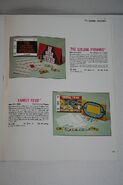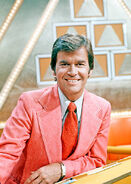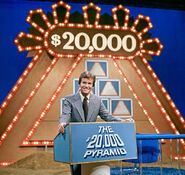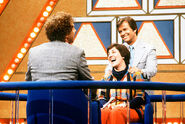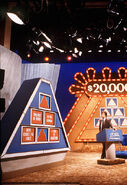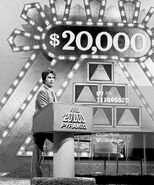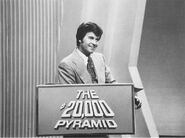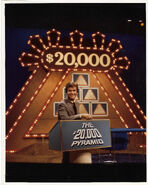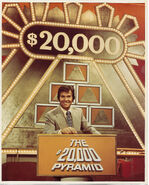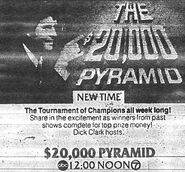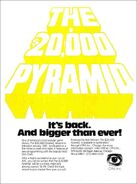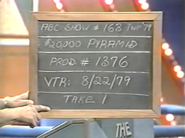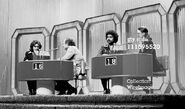| Aired | |
| ABC Daytime, January 19, 1976 - June 27, 1980 | |
| Number of episodes | |
| 1,149 (Daytime); 1 (Primetime Special) | |
| Run time | |
| 30 Minutes | |
| Host | |
| Dick Clark | |
| Announcer | |
| Bob Clayton (1976-1979) Steve O'Brien (1979-1980) | |
| Origination | |
| ABC Television Center (The Elysee Theater: TV-15) New York, New York | |
This is chronicling the 1976 version of The $20,000 Pyramid.
Game Format[]
Main Game[]
Two teams, each consisting of a celebrity guest and a studio contestant, attempted to guess a series of items relating to different categories within a short time limit based on clues given by their partners. The show's title referred to its pyramid-shaped game boards, both in the main game and in the bonus round, featuring six categories arranged in a triangular fashion. As always in the main game, each category's title was cleverly written in order to give team members a vague idea of what it was about (ex: "Loosen Up" - things that are stiff; "Made Public" - things that are used by the public; "The Woodsman" - things that a carpenter uses). Some categories also involved famous people, which contestants and celebrities both dreaded. Each team played each category in alternating order (their choice), and for each category, one person on the team had 30 seconds to describe seven items relating to that category to their partner. Teams scored 1 point for each correct answer (for a maximum of 7 points); if they passed on a word, they could not come back to it, but if the receiver guessed it right after it was passed, the team still earned a point for it. The clue giver could use voice inflections and hand/body movements while describing a word, but they could not say the actual word or any other part of it or else they would lose out on that potential point score (accompanied by a "cuckoo" sound effect). For the first two categories, the celebrities gave the clues, then the contestants gave the clues for the next two, and then for the final two, teams decided among themselves who would give or receive clues (the team that was trailing usually got first pick between the last two categories). The team in the lead after the sixth category moved on to the Winner's Circle.
Bonuses[]
During the front game, a bonus opportunity would arise, usually as a bonus card hidden behind one of the six categories in either game; when uncovered. the contestant partner had a chance to win either bonus money or a bonus prize which would be theirs to keep whether they won the game or not. Of course, to win the bonus, the team had to get all 7 answers right. In situations where a team didn't all 7 points to win on the very last category or they won the game automatically, if the very last category concealed the bonus card, the team was allowed to play the category all the way out to try and win the bonus prize.
- Big 7 - The team that exposed the Big 7 had 30 seconds to get all seven and win $500.
- Perfect 21 - If a team managed to achieve a perfect score of 21 points, then the contestant won $1,000 (later a merchandise prize).
Tie-Breaker[]
If the game ended in a tie, the game shifted into a tie-breaker situation. The team that caused the tie had a choice between two letters leaving the other for the other team. Both teams had 30 seconds to get as many of the seven items beginning with their letter(s) as they can. The teams continued building on their scores using the tie-breaker categories. This caused an achievement of very rare high scores. Extra ties kept the game going, and as soon as the tie was broken, the game was over. The team with the most points won the game.
Winner's Circle[]
The Winner's Circle essentially reversed the process: one member of the winning team had 60 seconds to describe six categories of increasing difficulty to their partner by listing items relating to each category. Contestants always had the option of whether they wanted to give or receive clues in the Winner's Circle, but celebrities usually gave the majority of the time. Regardless of who gave the clues, there were strict rules involving the types of clues players could not give in the Winner's Circle (see below):
- Clue givers could not use their hands (their chair had special straps attached to the arms to prevent them from doing so)
- Clue givers could not give away any part of the category itself or the essence thereof
- Clue givers had to use a short and concise list of clues; they could not use clues that were overly descriptive
- Clue givers could not use synonyms or prepositional phrases
- Clue givers' clues had to relate to the category itself
If the clue giver gave an illegal clue at any time, the category in play was thrown out, thus disqualifying the contestant from winning the grand prize. However, if this happened with time left on the clock and with unrevealed categories yet to be played, then the team was allowed to play the remainder of the Winner's Circle until time ran out or until the remaining categories were all correctly guessed. The three categories on the bottom row were worth $50 each, the next two were worth $100 each, and the final category was worth $200. If the team got all six right before the time expired, then the contestant partner won the grand prize.
The first trip to the Winner's Circle was worth $10,000. If that was lost, but the player made it back, the second was worth $15,000. If that was lost, then all subsequent trips were worth $20,000. Should a player win a Winner's Circle, all previous winnings would be augmented to the grand prize, and the player retired; otherwise they played in the next game with the other celebrity.
If a Friday show ended with a tie, the celebrities would play the final Winner's Circle of the week; all money earned was split between the contestants, and if the Winner's Circle was won, the contestants would split $5,000.
Tournament of Champions[]
From January 16-24, 1978, The $20,000 Pyramid held a special tournament featuring 8 of the 41 $20,000 winners from the previous calendar year, paired up with the celebrities who helped them win originally:
1/16: Anne Meara & Soupy Sales
1/17: Debralee Scott & LeVar Burton
1/18: Adrienne Barbeau & John Schuck
1/19: Lynn Redgrave & Rick Hurst
1/20: Soupy Sales & LeVar Burton
1/23: Lynn Redgrave & John Schuck
1/24: Lynn Redgrave & Soupy Sales
The first four shows were quarterfinals, followed by two semifinals and then the finals. On each show, the first Winner's Circle was worth $2,500 and the second was worth a total of $5,000. In addition, the individual amounts for each category changed, starting at $25 and increasing by $25 up to $100 for the fourth, then $150 for the fifth and $200 for the sixth. If there was a tie for money, each player played a half-Winner's Circle round, selecting either the bottom three subjects or the top three, and having :30 to get those subjects; whoever had the fastest time won.
In the finals, whomever had the highest score that day, or the one who won both front games, had their tournament earnings augmented to $20,000.
Merchandise[]
Board Games[]
Milton Bradley (1974 &1977-1979)[]
Five editions were made at the time.
Photos[]
Set Pics & Host[]
Print Ads[]
Trade Ads for a possible syndicated version.[]
Theatre Building[]
Production Slates[]
Press[]
Tickets[]
Contract[]
Episode Status[]
260 episodes from 1978 to 1980 are said to exist. A few scattered episodes from prior to 1978 also exist.
See Also: The $10,000/$25,000/$20,000 Pyramid/Episode Guide
Video[]
See Also[]
The $10,000 Pyramid
The $25,000 Pyramid
The $25,000 Pyramid (1982)
The $25,000 Pyramid (2010)
The $50,000 Pyramid
The $100,000 Pyramid
The $100,000 Pyramid (1991)
The $100,000 Pyramid (2000)
The $100,000 Pyramid (2016)
The $500,000 Pyramid
The $1,000,000 Pyramid (2000)
The $1,000,000 Pyramid (2009)
Pyramid (1996)
Pyramid (1997)
Pyramid (2002)
The Pyramid (2012)
Pyramid Rocks
The Junior Pyramid
Junior Partner Pyramid
All-Star Junior Pyramid






